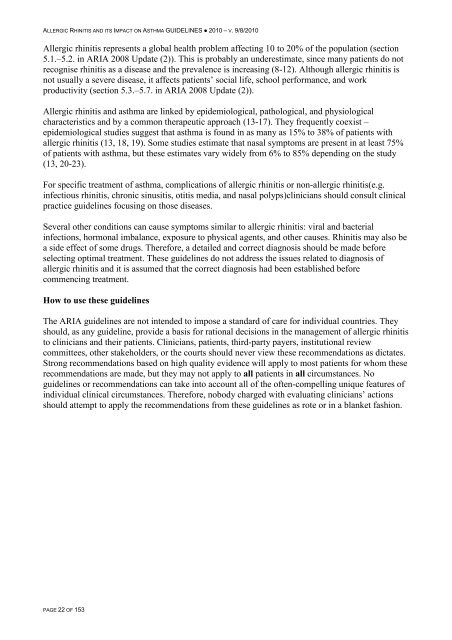Allergic Rhinitis and its Impact on Asthma - ARIA
Allergic Rhinitis and its Impact on Asthma - ARIA
Allergic Rhinitis and its Impact on Asthma - ARIA
Create successful ePaper yourself
Turn your PDF publications into a flip-book with our unique Google optimized e-Paper software.
ALLERGIC RHINITIS AND ITS IMPACT ON ASTHMA GUIDELINES ● 2010 – V. 9/8/2010<br />
<str<strong>on</strong>g>Allergic</str<strong>on</strong>g> rhinitis represents a global health problem affecting 10 to 20% of the populati<strong>on</strong> (secti<strong>on</strong><br />
5.1.–5.2. in <strong>ARIA</strong> 2008 Update (2)). This is probably an underestimate, since many patients do not<br />
recognise rhinitis as a disease <str<strong>on</strong>g>and</str<strong>on</strong>g> the prevalence is increasing (8-12). Although allergic rhinitis is<br />
not usually a severe disease, it affects patients’ social life, school performance, <str<strong>on</strong>g>and</str<strong>on</strong>g> work<br />
productivity (secti<strong>on</strong> 5.3.–5.7. in <strong>ARIA</strong> 2008 Update (2)).<br />
<str<strong>on</strong>g>Allergic</str<strong>on</strong>g> rhinitis <str<strong>on</strong>g>and</str<strong>on</strong>g> asthma are linked by epidemiological, pathological, <str<strong>on</strong>g>and</str<strong>on</strong>g> physiological<br />
characteristics <str<strong>on</strong>g>and</str<strong>on</strong>g> by a comm<strong>on</strong> therapeutic approach (13-17). They frequently coexist –<br />
epidemiological studies suggest that asthma is found in as many as 15% to 38% of patients with<br />
allergic rhinitis (13, 18, 19). Some studies estimate that nasal symptoms are present in at least 75%<br />
of patients with asthma, but these estimates vary widely from 6% to 85% depending <strong>on</strong> the study<br />
(13, 20-23).<br />
For specific treatment of asthma, complicati<strong>on</strong>s of allergic rhinitis or n<strong>on</strong>-allergic rhinitis(e.g.<br />
infectious rhinitis, chr<strong>on</strong>ic sinusitis, otitis media, <str<strong>on</strong>g>and</str<strong>on</strong>g> nasal polyps)clinicians should c<strong>on</strong>sult clinical<br />
practice guidelines focusing <strong>on</strong> those diseases.<br />
Several other c<strong>on</strong>diti<strong>on</strong>s can cause symptoms similar to allergic rhinitis: viral <str<strong>on</strong>g>and</str<strong>on</strong>g> bacterial<br />
infecti<strong>on</strong>s, horm<strong>on</strong>al imbalance, exposure to physical agents, <str<strong>on</strong>g>and</str<strong>on</strong>g> other causes. <str<strong>on</strong>g>Rhinitis</str<strong>on</strong>g> may also be<br />
a side effect of some drugs. Therefore, a detailed <str<strong>on</strong>g>and</str<strong>on</strong>g> correct diagnosis should be made before<br />
selecting optimal treatment. These guidelines do not address the issues related to diagnosis of<br />
allergic rhinitis <str<strong>on</strong>g>and</str<strong>on</strong>g> it is assumed that the correct diagnosis had been established before<br />
commencing treatment.<br />
How to use these guidelines<br />
The <strong>ARIA</strong> guidelines are not intended to impose a st<str<strong>on</strong>g>and</str<strong>on</strong>g>ard of care for individual countries. They<br />
should, as any guideline, provide a basis for rati<strong>on</strong>al decisi<strong>on</strong>s in the management of allergic rhinitis<br />
to clinicians <str<strong>on</strong>g>and</str<strong>on</strong>g> their patients. Clinicians, patients, third-party payers, instituti<strong>on</strong>al review<br />
committees, other stakeholders, or the courts should never view these recommendati<strong>on</strong>s as dictates.<br />
Str<strong>on</strong>g recommendati<strong>on</strong>s based <strong>on</strong> high quality evidence will apply to most patients for whom these<br />
recommendati<strong>on</strong>s are made, but they may not apply to all patients in all circumstances. No<br />
guidelines or recommendati<strong>on</strong>s can take into account all of the often-compelling unique features of<br />
individual clinical circumstances. Therefore, nobody charged with evaluating clinicians’ acti<strong>on</strong>s<br />
should attempt to apply the recommendati<strong>on</strong>s from these guidelines as rote or in a blanket fashi<strong>on</strong>.<br />
PAGE 22 OF 153


